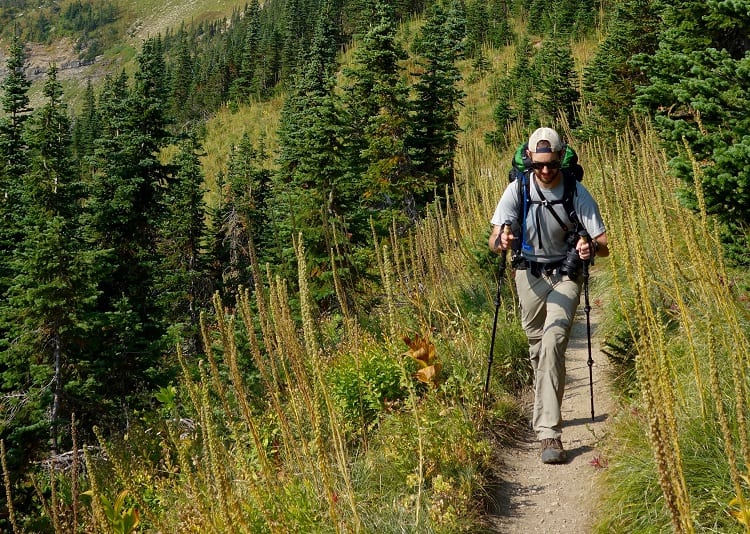My first run-in with trekking poles wasn’t a positive experience. I was hiking the Inca Trail in Peru, hustling to see the sunrise over Mach Picchu, when I came up behind a succession of slow-moving hikers.
Clickety-clack. Clickety-clack. Clickety-clack.
The trail was narrow, and I couldn’t get past the group due to their persistent use of poles. I was annoyed, frustration growing with each stride. Thankfully, they stopped to rest soon after and I was able to hurry past — and catch that sunrise.
“Trekking poles…pfffft.” I vowed never to use them.
Fast-forward several hiking trips (and two creaky knees) later, and my attitude has done an about-face. A friend convinced me to try trekking poles during a hike through the Grand Canyon. “They’ll save your knees, bro,” he claimed.
Fair enough. I need my knees.
I tried them, and I loved them. Even more importantly, my knees loved them. My affinity for the hiking helpers continues to this day.
But, for the uninitiated, the question remains: When should you consider using trekking poles?
“On uneven terrain, slick conditions, long descents, extended climbs,” advised Joe Dann, senior guide at adventure travel company Fit4Adventure and REI St. Louis expert. “If you’re carrying a backpack, trekking poles can help you balance the load.”
Know Your Poles
So, a pole is a pole. Right? Yes and no. There are a few differentiating factors to consider:
Grips. There are three types of grips: rubber, cork, and foam. Rubber is sturdy and shock-absorbing but can chafe and cause blisters on sweaty hikes. Cork is softer, though it will break down over time. Foam has a comfortable feel, absorbs sweat, and has a longer life.
Pole material. Shafts are typically aluminum or carbon/composite. Aluminum is heavier and more durable (will bend under stress), while carbon/composite is lighter but more likely to shatter. Carbon poles usually are more expensive due to their lighter weight.
Adjustable vs Fixed-Length. Adjustable poles let you make modifications. The downside is the locking mechanisms can loosen over time, resulting in slippage or failure on the trail. Fixed-length poles often have longer grips, providing utility without having to adjust the pole.
Packability. TSA regulations require that poles be placed in checked baggage. If you plan on frequent travel with your poles, collapsible models are a good option.
Pro Tips
- You’ll want your arm at a 90-degree angle, so look for a pole that fits your height.
- Lengthen your pole on descents to help absorb shock to your knees; shorten on climbs to use the pole as uphill propulsion.
- When employing the straps, run your hand up through the loop, then grip down, using your palm along your thumb to secure the strap against the pole.
- If the trail is soft, consider using tip covers to keep the pole tips from getting stuck in the mud. Rubber covers also provide superior traction on rocky trails. Baskets are available for snowy conditions.
- For photographers, poles can replace a tripod. Some poles even have camera adapters on the tops.
- For ultralight backpackers, trekking poles can replace tent poles, open up vestibules or support minimalist tarp shelters
- When needed, poles make the ideal supports for backcountry splints.
“People see poles run up to $160+ and decide they don’t need them because they don’t want to spend that kind of money,” said Dann. “Any pole is better than no pole. Find what fits your budget and functionality, and you’ll be prepared for whatever the trail throws your way.”
_________________________
Point of Contact
Trekking poles reduce impact on your legs, enhance stability, and increase traction and speed. Here are three models to consider:
REI Co-op Flash Carbon

Adjustable, with a breathable foam grip. The three-section design increases stability; minimalist baskets reduce total weight. $139/pair. rei.com.
Black Diamond Distance Z

A simple, one-pull design allows the poles to collapse to 1/3 their full length. Extended foam grips provide great feel; aluminum shafts are durable in the roughest terrain. $100/pair. blackdiamondequipment.com.
Kelty Discovery 2.0

Cork grips with foam accents absorb sweat and eliminate chafing. Internal shock-absorption system minimizes impact; twist locks make for easy adjustments. $60/pair. kelty.com
Author: Nick Tilley is a regular contributor to Terrain Magazine


Thank you so much for these recommendations. I’ve never used poles before but over the last few months, I’ve begun to see how useful they could be. On a recent trip to the Atlas Mountains, I sprained one of my knees (I think I actually did it on the ridiculously steep stairs in our riad) but I think having poles would have made hiking during the rest of my trip a lot more comfortable. I’m also pretty rubbish at getting down things (useful, I know) so I think it’d be handy to have some extra support when descending.
Glad you enjoyed the article- trekking poles can make all the difference between a great hike and an awful one due to sore knees and joints. Thanks for reading, Scott!